Elasticity and Its Application Chapter 5 Copyright ©





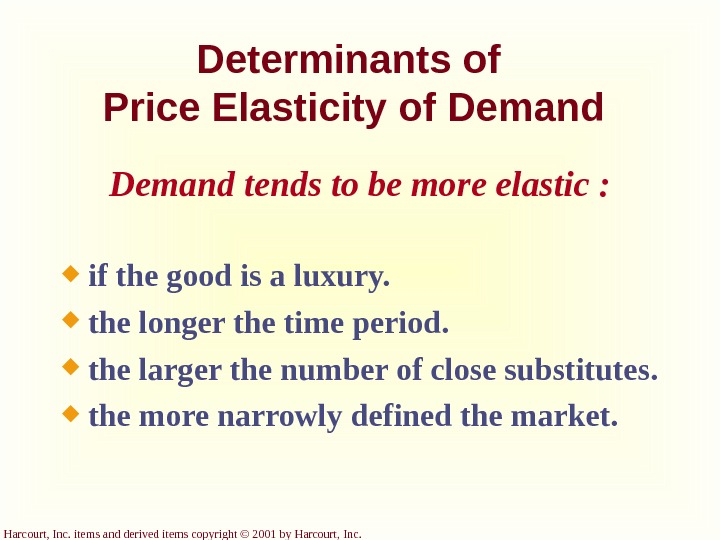
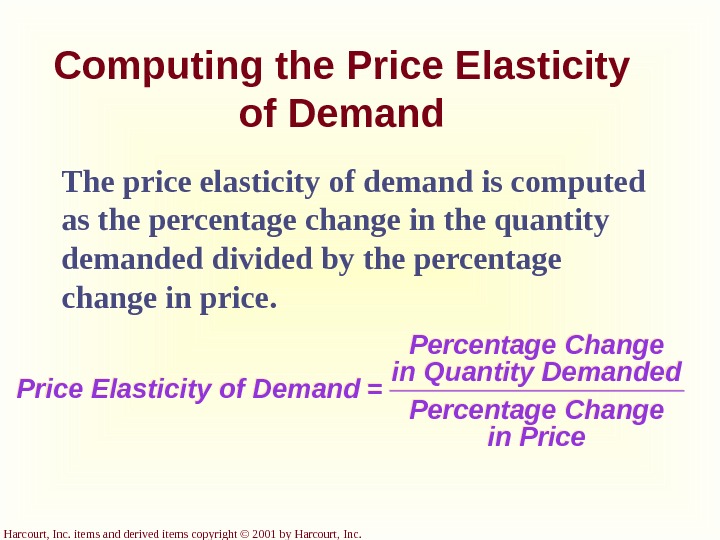

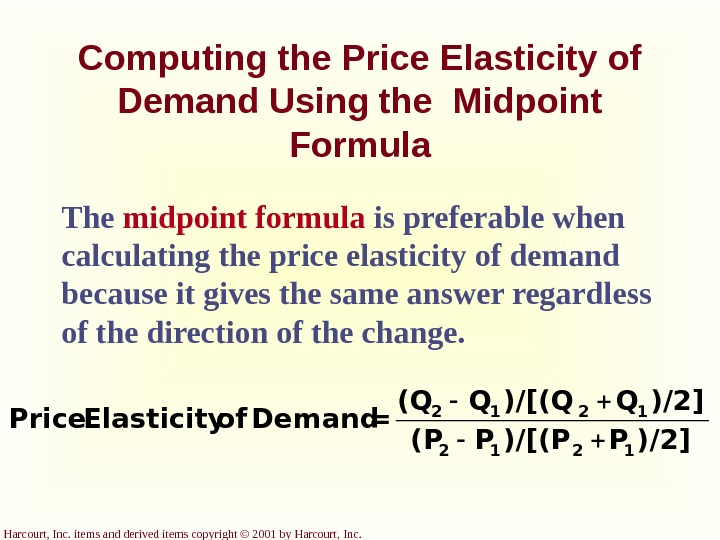
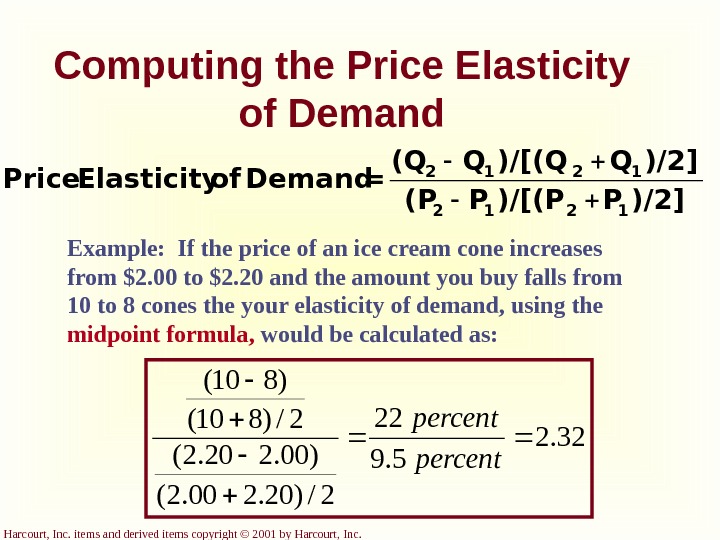

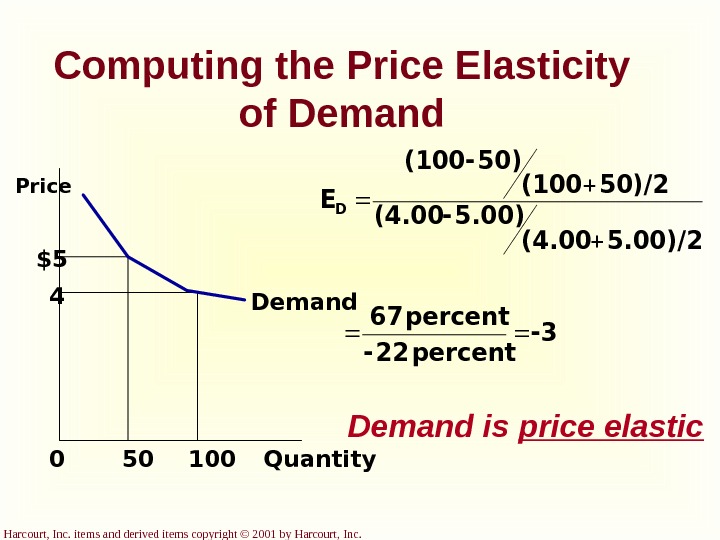

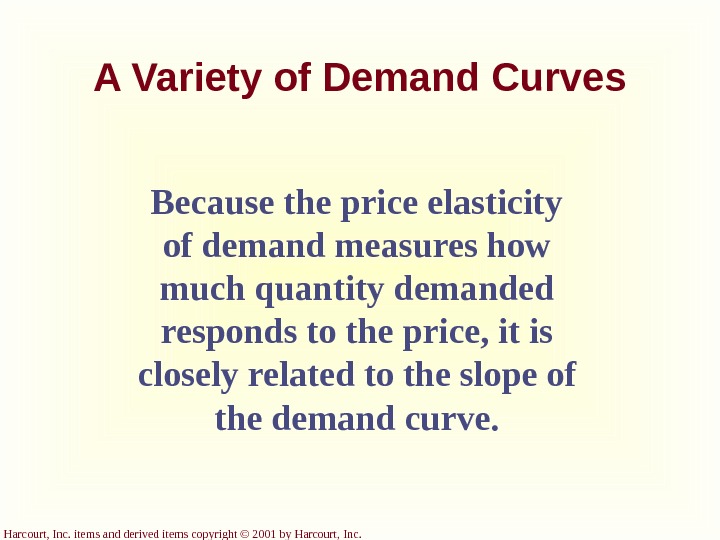
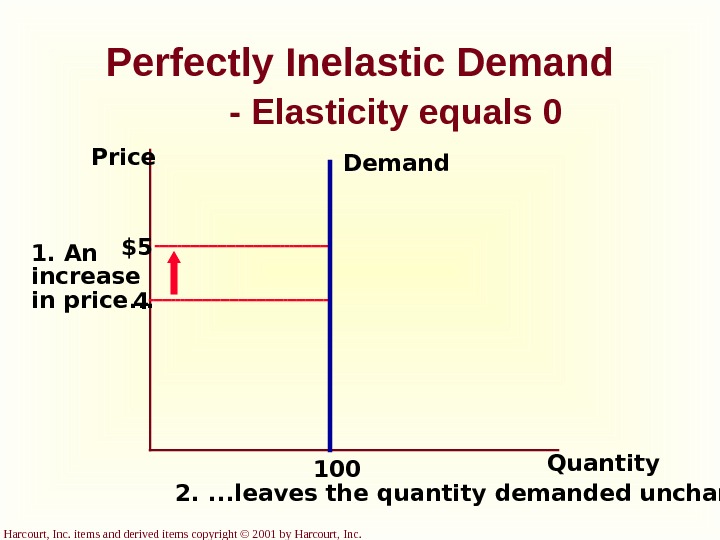




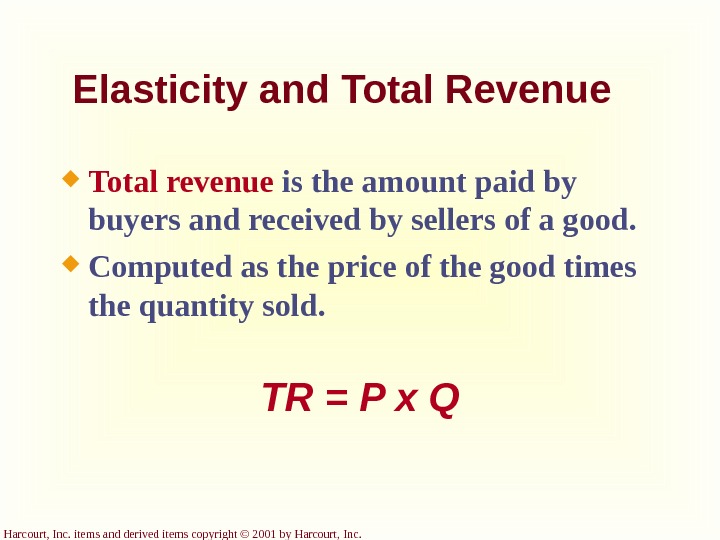
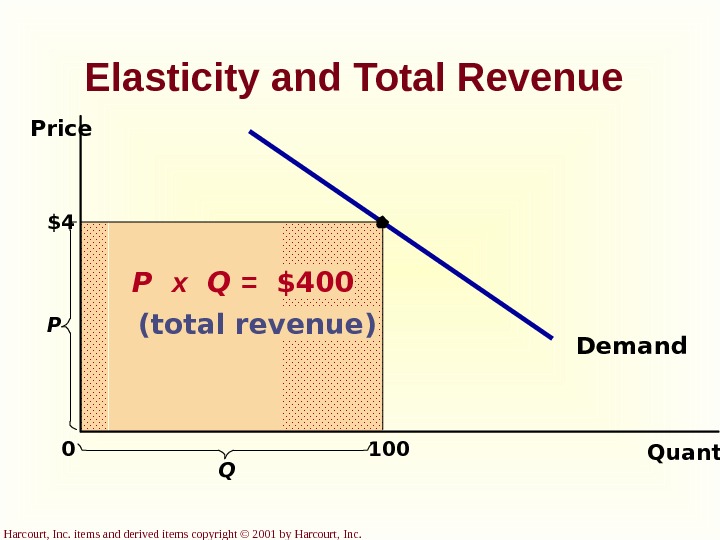

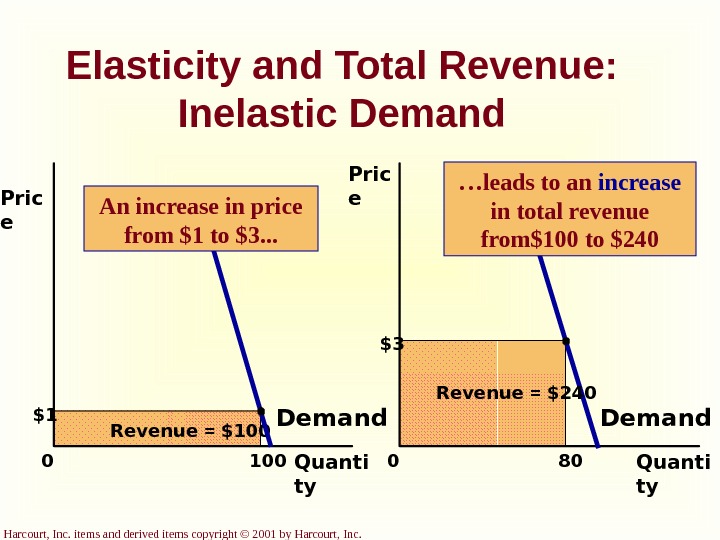
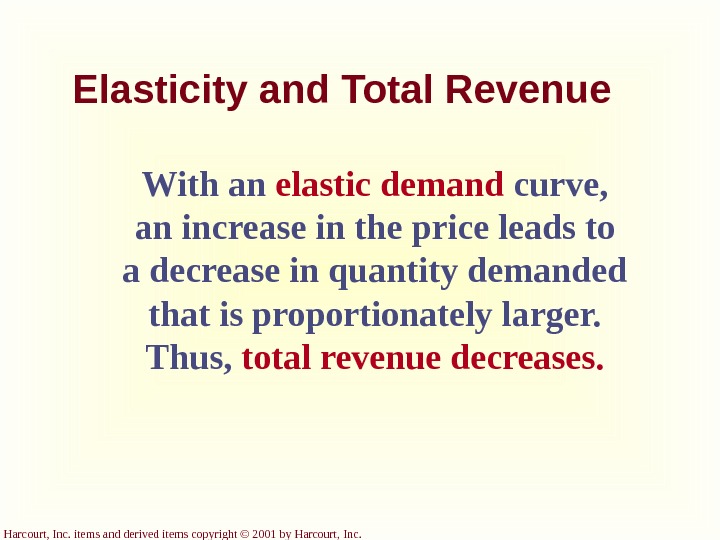

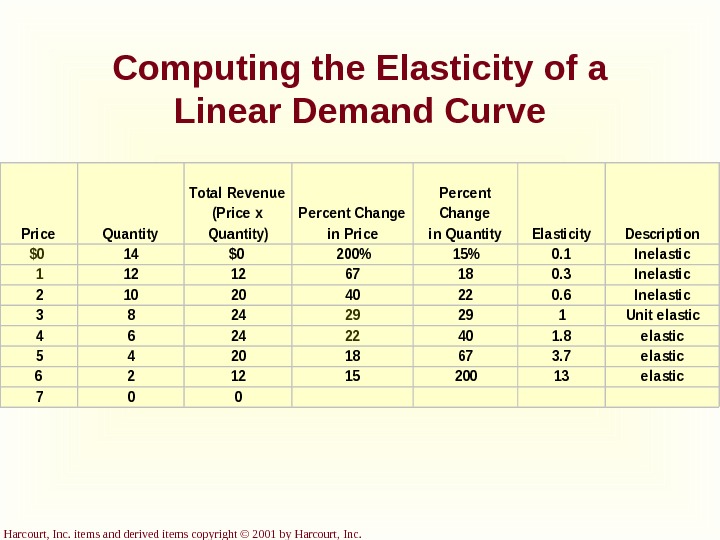


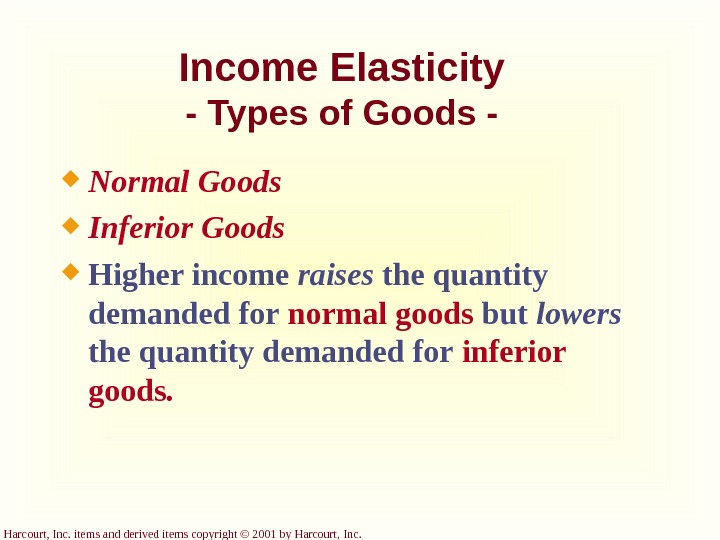


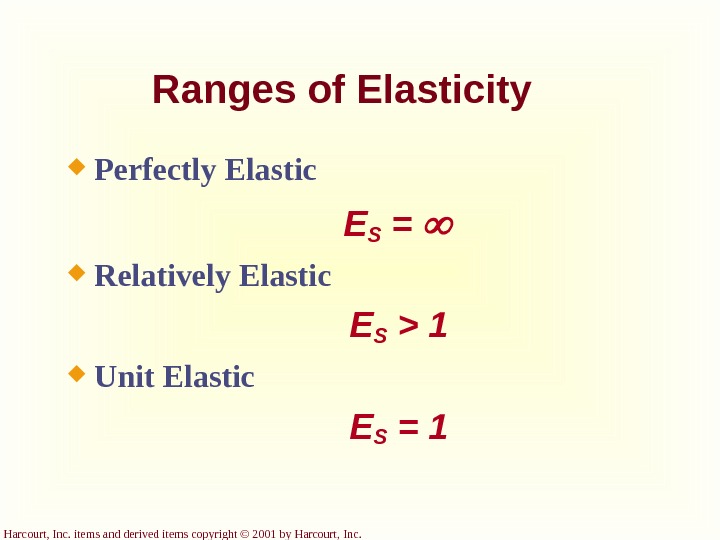




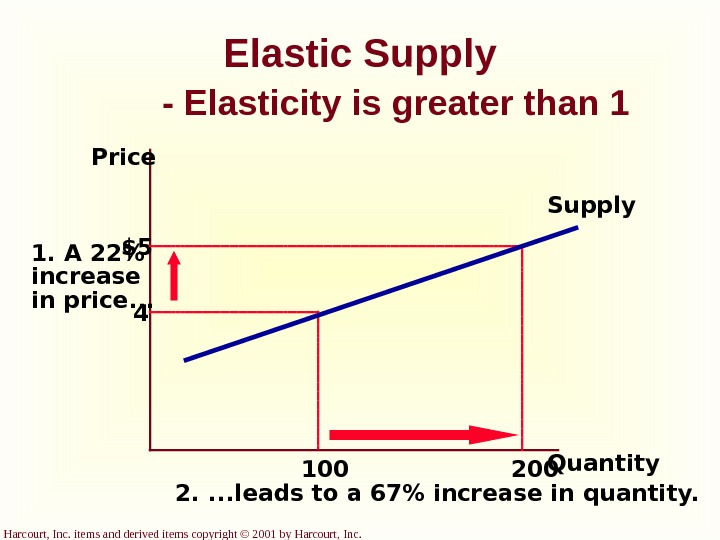


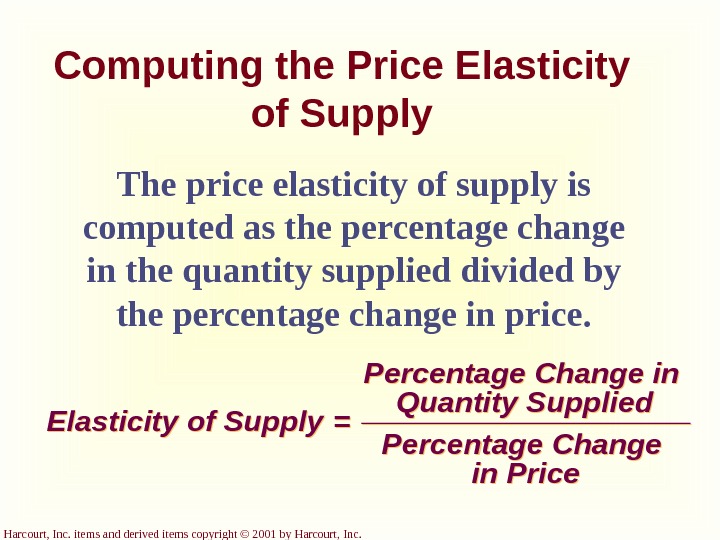

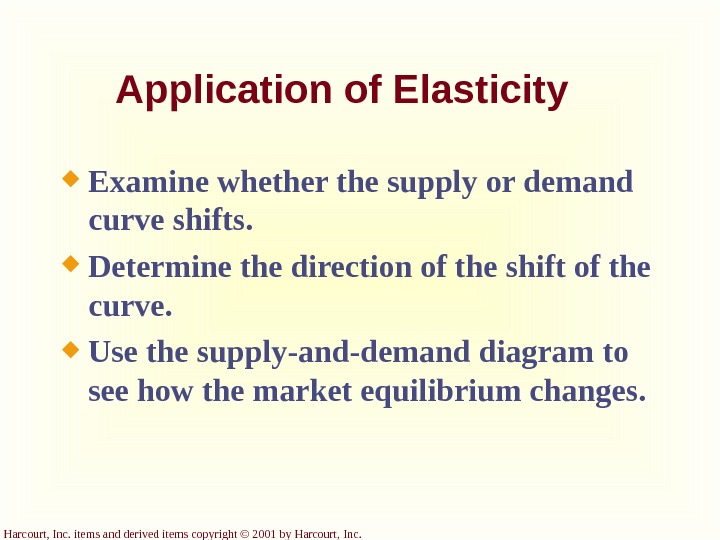

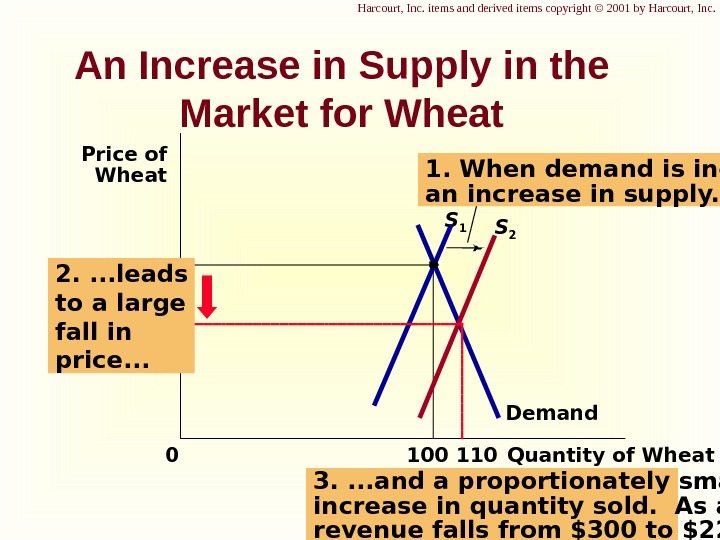
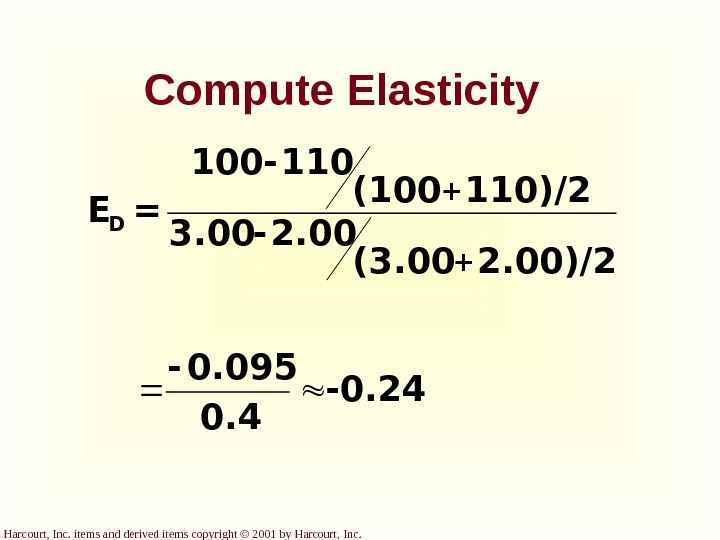
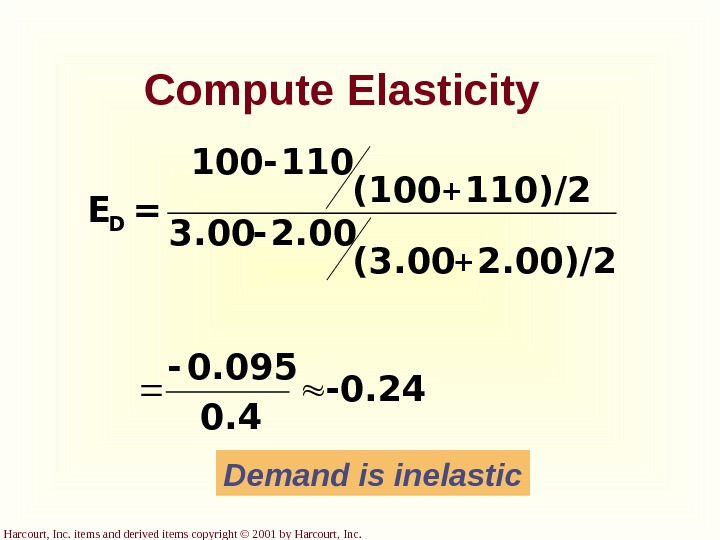
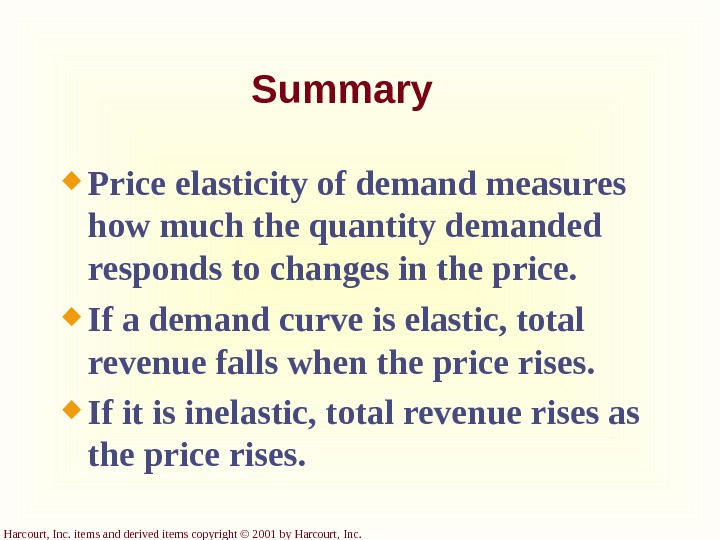


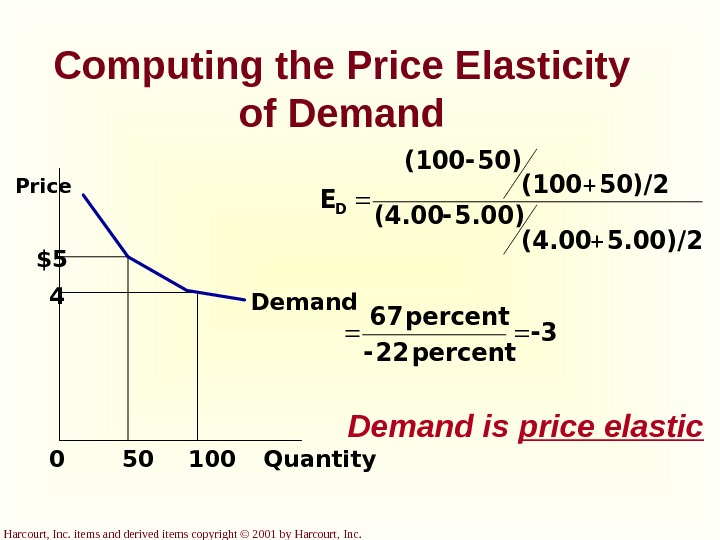

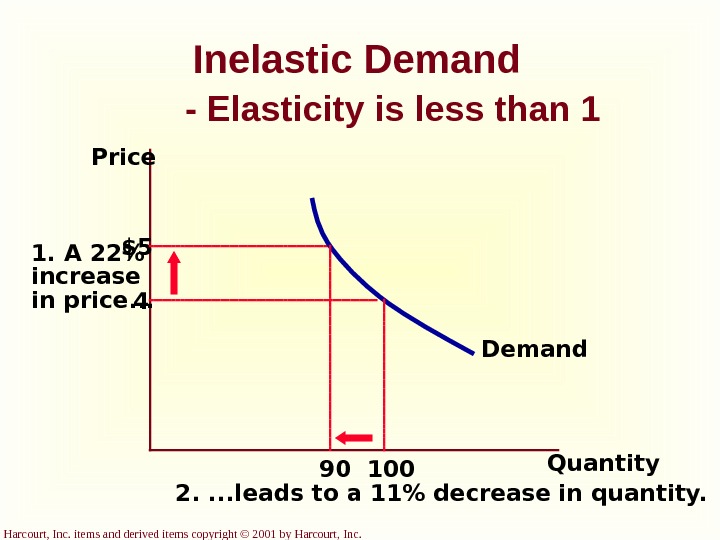
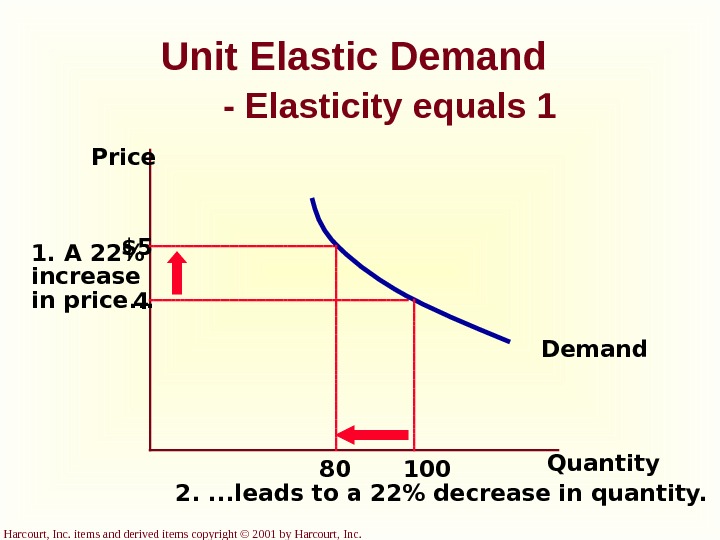
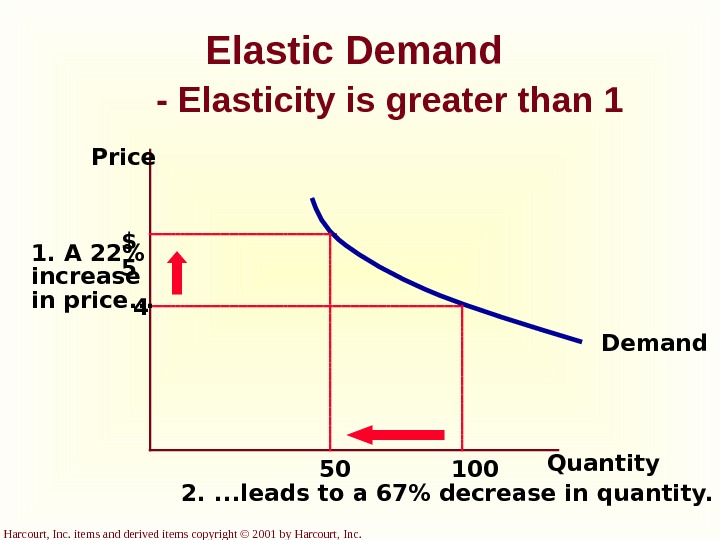
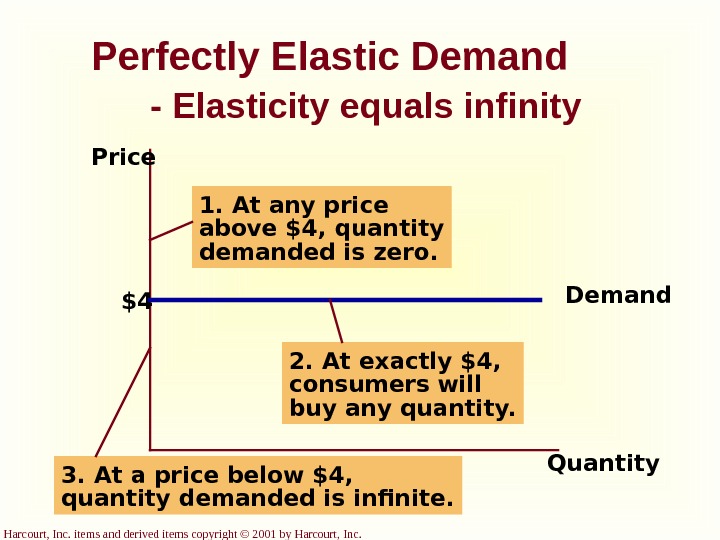
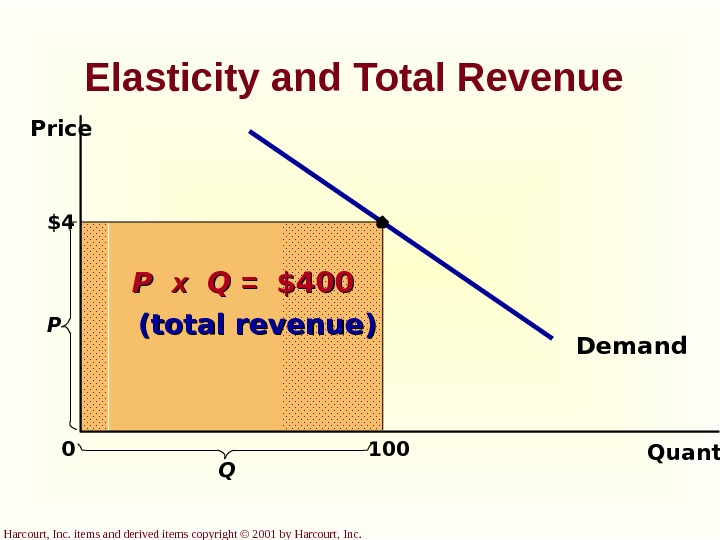
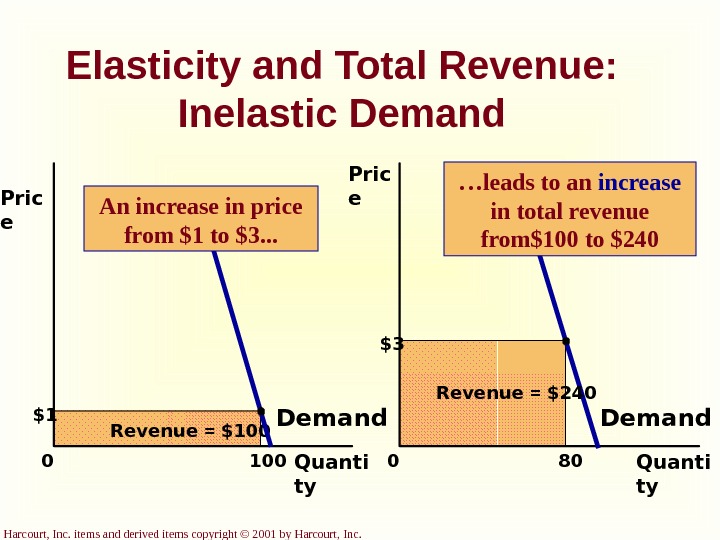

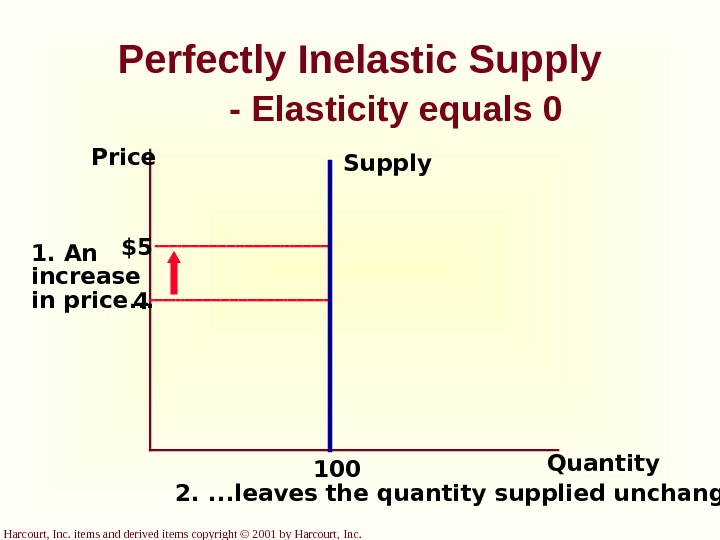

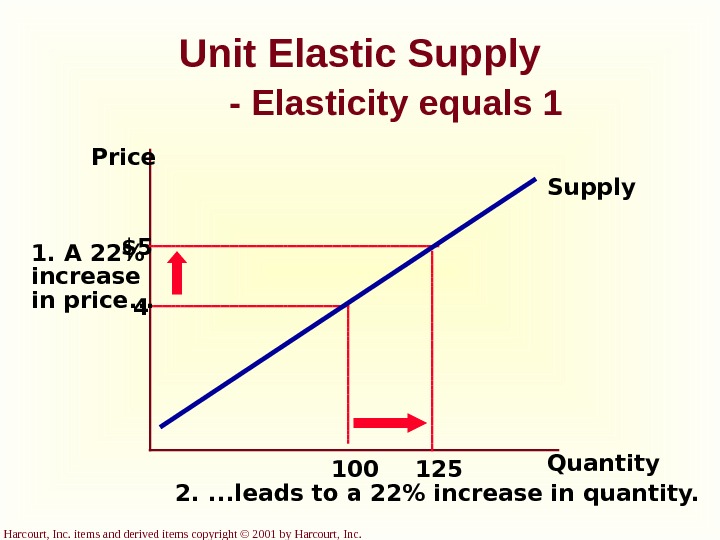

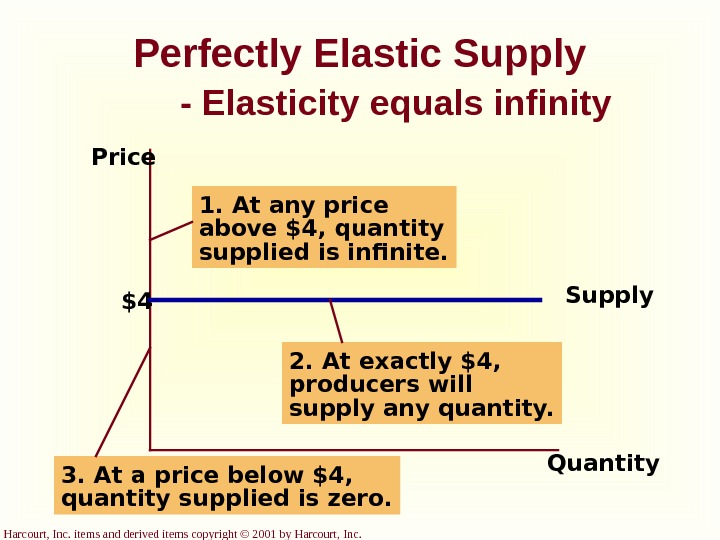


chap05_-_elasticity_and_its_application.ppt
- Размер: 479.5 Кб
- Количество слайдов: 64
Описание презентации Elasticity and Its Application Chapter 5 Copyright © по слайдам
 Elasticity and Its Application Chapter 5 Copyright © 2001 by Harcourt, Inc. All rights reserved. Requests for permission to make copies of any part of the work should be mailed to: Permissions Department, Harcourt College Publishers, 6277 Sea Harbor Drive, Orlando, Florida 32887 -6777.
Elasticity and Its Application Chapter 5 Copyright © 2001 by Harcourt, Inc. All rights reserved. Requests for permission to make copies of any part of the work should be mailed to: Permissions Department, Harcourt College Publishers, 6277 Sea Harbor Drive, Orlando, Florida 32887 -6777.
 Harcourt, Inc. items and derived items copyright © 2001 by Harcourt, Inc. Elasticity. . . … is a measure of how much buyers and sellers respond to changes in market conditions … allows us to analyze supply and demand with greater precision.
Harcourt, Inc. items and derived items copyright © 2001 by Harcourt, Inc. Elasticity. . . … is a measure of how much buyers and sellers respond to changes in market conditions … allows us to analyze supply and demand with greater precision.
 Harcourt, Inc. items and derived items copyright © 2001 by Harcourt, Inc. Price Elasticity of Demand Price elasticity of demand is the percentage change in quantity demanded given a percent change in the price. It is a measure of how much the quantity demanded of a good responds to a change in the price of that good.
Harcourt, Inc. items and derived items copyright © 2001 by Harcourt, Inc. Price Elasticity of Demand Price elasticity of demand is the percentage change in quantity demanded given a percent change in the price. It is a measure of how much the quantity demanded of a good responds to a change in the price of that good.
 Harcourt, Inc. items and derived items copyright © 2001 by Harcourt, Inc. Determinants of Price Elasticity of Demand Necessities versus Luxuries Availability of Close Substitutes Definition of the Market Time Horizon
Harcourt, Inc. items and derived items copyright © 2001 by Harcourt, Inc. Determinants of Price Elasticity of Demand Necessities versus Luxuries Availability of Close Substitutes Definition of the Market Time Horizon
 Harcourt, Inc. items and derived items copyright © 2001 by Harcourt, Inc. Determinants of Price Elasticity of Demand tends to be more elastic : if the good is a luxury. the longer the time period. the larger the number of close substitutes. the more narrowly defined the market.
Harcourt, Inc. items and derived items copyright © 2001 by Harcourt, Inc. Determinants of Price Elasticity of Demand tends to be more elastic : if the good is a luxury. the longer the time period. the larger the number of close substitutes. the more narrowly defined the market.
 Harcourt, Inc. items and derived items copyright © 2001 by Harcourt, Inc. Computing the Price Elasticity of Demand The price elasticity of demand is computed as the percentage change in the quantity demanded divided by the percentage change in price. Price Elasticity of Demand= Percentage Change in Quantity Demanded Percentage Change in Price
Harcourt, Inc. items and derived items copyright © 2001 by Harcourt, Inc. Computing the Price Elasticity of Demand The price elasticity of demand is computed as the percentage change in the quantity demanded divided by the percentage change in price. Price Elasticity of Demand= Percentage Change in Quantity Demanded Percentage Change in Price
 Harcourt, Inc. items and derived items copyright © 2001 by Harcourt, Inc. Computing the Price Elasticity of Demandprice inchange Percentage demandedquatity inchange Percentage demand of elasticity. Price Example: If the price of an ice cream cone increases from $2. 00 to $2. 20 and the amount you buy falls from 10 to 8 cones then your elasticity of demand would be calculated as: 2 percent 10 percent 20 100 002202 100 10 810 . ). . ( )(
Harcourt, Inc. items and derived items copyright © 2001 by Harcourt, Inc. Computing the Price Elasticity of Demandprice inchange Percentage demandedquatity inchange Percentage demand of elasticity. Price Example: If the price of an ice cream cone increases from $2. 00 to $2. 20 and the amount you buy falls from 10 to 8 cones then your elasticity of demand would be calculated as: 2 percent 10 percent 20 100 002202 100 10 810 . ). . ( )(
 Harcourt, Inc. items and derived items copyright © 2001 by Harcourt, Inc. Computing the Price Elasticity of Demand Using the Midpoint Formula The midpoint formula is preferable when calculating the price elasticity of demand because it gives the same answer regardless of the direction of the change. )/2]P)/[(PP(P )/2]Q)/[(QQ(Q =Demand of Elasticity Price
Harcourt, Inc. items and derived items copyright © 2001 by Harcourt, Inc. Computing the Price Elasticity of Demand Using the Midpoint Formula The midpoint formula is preferable when calculating the price elasticity of demand because it gives the same answer regardless of the direction of the change. )/2]P)/[(PP(P )/2]Q)/[(QQ(Q =Demand of Elasticity Price
 Harcourt, Inc. items and derived items copyright © 2001 by Harcourt, Inc. Computing the Price Elasticity of Demand Example: If the price of an ice cream cone increases from $2. 00 to $2. 20 and the amount you buy falls from 10 to 8 cones the your elasticity of demand, using the midpoint formula, would be calculated as: 32. 2 5. 9 22 2/)20. 200. 2( )00. 220. 2( 2/)810( percent )/2]P)/[(PP(P )/2]Q)/[(QQ(Q =Demand of Elasticity Price
Harcourt, Inc. items and derived items copyright © 2001 by Harcourt, Inc. Computing the Price Elasticity of Demand Example: If the price of an ice cream cone increases from $2. 00 to $2. 20 and the amount you buy falls from 10 to 8 cones the your elasticity of demand, using the midpoint formula, would be calculated as: 32. 2 5. 9 22 2/)20. 200. 2( )00. 220. 2( 2/)810( percent )/2]P)/[(PP(P )/2]Q)/[(QQ(Q =Demand of Elasticity Price
 Harcourt, Inc. items and derived items copyright © 2001 by Harcourt, Inc. Ranges of Elasticity Inelastic Demand Quantity demanded does not respond strongly to price changes. Price elasticity of demand is less than one. Elastic Demand Quantity demanded responds strongly to changes in price. Price elasticity of demand is greater than one.
Harcourt, Inc. items and derived items copyright © 2001 by Harcourt, Inc. Ranges of Elasticity Inelastic Demand Quantity demanded does not respond strongly to price changes. Price elasticity of demand is less than one. Elastic Demand Quantity demanded responds strongly to changes in price. Price elasticity of demand is greater than one.
 Harcourt, Inc. items and derived items copyright © 2001 by Harcourt, Inc. Computing the Price Elasticity of Demand is price elastic$5 4 Demand Quantity 1000 Price 50 -3 percent 22 — percent 67 5. 00)/2(4. 00 5. 00)-(4. 00 50)/2(100 50)-(
Harcourt, Inc. items and derived items copyright © 2001 by Harcourt, Inc. Computing the Price Elasticity of Demand is price elastic$5 4 Demand Quantity 1000 Price 50 -3 percent 22 — percent 67 5. 00)/2(4. 00 5. 00)-(4. 00 50)/2(100 50)-(
 Harcourt, Inc. items and derived items copyright © 2001 by Harcourt, Inc. Ranges of Elasticity Perfectly Inelastic Quantity demanded does not respond to price changes. Perfectly Elastic Quantity demanded changes infinitely with any change in price. Unit Elastic Quantity demanded changes by the same percentage as the price.
Harcourt, Inc. items and derived items copyright © 2001 by Harcourt, Inc. Ranges of Elasticity Perfectly Inelastic Quantity demanded does not respond to price changes. Perfectly Elastic Quantity demanded changes infinitely with any change in price. Unit Elastic Quantity demanded changes by the same percentage as the price.
 Harcourt, Inc. items and derived items copyright © 2001 by Harcourt, Inc. A Variety of Demand Curves Because the price elasticity of demand measures how much quantity demanded responds to the price, it is closely related to the slope of the demand curve.
Harcourt, Inc. items and derived items copyright © 2001 by Harcourt, Inc. A Variety of Demand Curves Because the price elasticity of demand measures how much quantity demanded responds to the price, it is closely related to the slope of the demand curve.
 Harcourt, Inc. items and derived items copyright © 2001 by Harcourt, Inc. Perfectly Inelastic Demand — Elasticity equals 0 Quantity. Price 4$5 Demand 100 2. . leaves the quantity demanded unchanged. 1. An increase in price. . .
Harcourt, Inc. items and derived items copyright © 2001 by Harcourt, Inc. Perfectly Inelastic Demand — Elasticity equals 0 Quantity. Price 4$5 Demand 100 2. . leaves the quantity demanded unchanged. 1. An increase in price. . .
 Harcourt, Inc. items and derived items copyright © 2001 by Harcourt, Inc. Inelastic Demand — Elasticity is less than 1 Quantity. Price 4$5 1. A 22% increase in price. . . Demand 10090 2. . leads to a 11% decrease in quantity.
Harcourt, Inc. items and derived items copyright © 2001 by Harcourt, Inc. Inelastic Demand — Elasticity is less than 1 Quantity. Price 4$5 1. A 22% increase in price. . . Demand 10090 2. . leads to a 11% decrease in quantity.
 Harcourt, Inc. items and derived items copyright © 2001 by Harcourt, Inc. Unit Elastic Demand — Elasticity equals 1 Quantity. Price 4$5 1. A 22% increase in price. . . Demand 10080 2. . leads to a 22% decrease in quantity.
Harcourt, Inc. items and derived items copyright © 2001 by Harcourt, Inc. Unit Elastic Demand — Elasticity equals 1 Quantity. Price 4$5 1. A 22% increase in price. . . Demand 10080 2. . leads to a 22% decrease in quantity.
 Harcourt, Inc. items and derived items copyright © 2001 by Harcourt, Inc. Elastic Demand — Elasticity is greater than 1 Quantity. Price 4$ 51. A 22% increase in price. . . Demand 10050 2. . leads to a 67% decrease in quantity.
Harcourt, Inc. items and derived items copyright © 2001 by Harcourt, Inc. Elastic Demand — Elasticity is greater than 1 Quantity. Price 4$ 51. A 22% increase in price. . . Demand 10050 2. . leads to a 67% decrease in quantity.
 Harcourt, Inc. items and derived items copyright © 2001 by Harcourt, Inc. Perfectly Elastic Demand — Elasticity equals infinity Quantity. Price Demand $4 1. At any price above $4, quantity demanded is zero. 2. At exactly $4, consumers will buy any quantity. 3. At a price below $4, quantity demanded is infinite.
Harcourt, Inc. items and derived items copyright © 2001 by Harcourt, Inc. Perfectly Elastic Demand — Elasticity equals infinity Quantity. Price Demand $4 1. At any price above $4, quantity demanded is zero. 2. At exactly $4, consumers will buy any quantity. 3. At a price below $4, quantity demanded is infinite.
 Harcourt, Inc. items and derived items copyright © 2001 by Harcourt, Inc. Elasticity and Total Revenue Total revenue is the amount paid by buyers and received by sellers of a good. Computed as the price of the good times the quantity sold. TR = P x Q
Harcourt, Inc. items and derived items copyright © 2001 by Harcourt, Inc. Elasticity and Total Revenue Total revenue is the amount paid by buyers and received by sellers of a good. Computed as the price of the good times the quantity sold. TR = P x Q
 Harcourt, Inc. items and derived items copyright © 2001 by Harcourt, Inc. $4 Demand Quantity. P 0 Price P x Q = $400 (total revenue) 100 QElasticity and Total Revenue
Harcourt, Inc. items and derived items copyright © 2001 by Harcourt, Inc. $4 Demand Quantity. P 0 Price P x Q = $400 (total revenue) 100 QElasticity and Total Revenue
 Harcourt, Inc. items and derived items copyright © 2001 by Harcourt, Inc. Elasticity and Total Revenue With an inelastic demand curve, an increase in price leads to a decrease in quantity that is proportionately smaller. Thus, total revenue increases.
Harcourt, Inc. items and derived items copyright © 2001 by Harcourt, Inc. Elasticity and Total Revenue With an inelastic demand curve, an increase in price leads to a decrease in quantity that is proportionately smaller. Thus, total revenue increases.
 Harcourt, Inc. items and derived items copyright © 2001 by Harcourt, Inc. Elasticity and Total Revenue: Inelastic Demand $3 Quanti ty 0 Pric e 80 Revenue = $240 Demand$1 Demand Quanti ty 0 Revenue = $100 Pric e An increase in price from $1 to $3. . . … leads to an increase in total revenue from$100 to $
Harcourt, Inc. items and derived items copyright © 2001 by Harcourt, Inc. Elasticity and Total Revenue: Inelastic Demand $3 Quanti ty 0 Pric e 80 Revenue = $240 Demand$1 Demand Quanti ty 0 Revenue = $100 Pric e An increase in price from $1 to $3. . . … leads to an increase in total revenue from$100 to $
 Harcourt, Inc. items and derived items copyright © 2001 by Harcourt, Inc. Elasticity and Total Revenue With an elastic demand curve, an increase in the price leads to a decrease in quantity demanded that is proportionately larger. Thus, total revenue decreases.
Harcourt, Inc. items and derived items copyright © 2001 by Harcourt, Inc. Elasticity and Total Revenue With an elastic demand curve, an increase in the price leads to a decrease in quantity demanded that is proportionately larger. Thus, total revenue decreases.
 Harcourt, Inc. items and derived items copyright © 2001 by Harcourt, Inc. Elasticity and Total Revenue: Elastic Demand Quantity 0 Price $4 50 Demand Quantity 0 Price Revenue = $100 $5 20 Revenue = $200 An increase in price from $4 to $5. . . … leads to a decrease in total revenue from$200 to $
Harcourt, Inc. items and derived items copyright © 2001 by Harcourt, Inc. Elasticity and Total Revenue: Elastic Demand Quantity 0 Price $4 50 Demand Quantity 0 Price Revenue = $100 $5 20 Revenue = $200 An increase in price from $4 to $5. . . … leads to a decrease in total revenue from$200 to $
 Harcourt, Inc. items and derived items copyright © 2001 by Harcourt, Inc. Computing the Elasticity of a Linear Demand Curve. Price. Qua ntity Tota l Re ve nue (Price x Qua ntity) Pe rce nt Cha nge in Price Pe rce nt Cha nge in Qua ntity. Ela sticity. De scription $014$0200%15%0. 1 Ine la stic 1121267180. 3 Ine la stic 2102040220. 6 Ine la stic 382429291 Unit e la stic 462422401. 8 e la stic 542018673. 7 e la stic 62121520013 e la stic
Harcourt, Inc. items and derived items copyright © 2001 by Harcourt, Inc. Computing the Elasticity of a Linear Demand Curve. Price. Qua ntity Tota l Re ve nue (Price x Qua ntity) Pe rce nt Cha nge in Price Pe rce nt Cha nge in Qua ntity. Ela sticity. De scription $014$0200%15%0. 1 Ine la stic 1121267180. 3 Ine la stic 2102040220. 6 Ine la stic 382429291 Unit e la stic 462422401. 8 e la stic 542018673. 7 e la stic 62121520013 e la stic
 Harcourt, Inc. items and derived items copyright © 2001 by Harcourt, Income Elasticity of Demand Income elasticity of demand measures how much the quantity demanded of a good responds to a change in consumers’ income. It is computed as the percentage change in the quantity demanded divided by the percentage change in income.
Harcourt, Inc. items and derived items copyright © 2001 by Harcourt, Income Elasticity of Demand Income elasticity of demand measures how much the quantity demanded of a good responds to a change in consumers’ income. It is computed as the percentage change in the quantity demanded divided by the percentage change in income.
 Harcourt, Inc. items and derived items copyright © 2001 by Harcourt, Inc. Computing Income Elasticity of Demand Percentage Change in Quantity Demanded Percentage Change in Income=
Harcourt, Inc. items and derived items copyright © 2001 by Harcourt, Inc. Computing Income Elasticity of Demand Percentage Change in Quantity Demanded Percentage Change in Income=
 Harcourt, Inc. items and derived items copyright © 2001 by Harcourt, Income Elasticity — Types of Goods — Normal Goods Inferior Goods Higher income raises the quantity demanded for normal goods but lowers the quantity demanded for inferior goods.
Harcourt, Inc. items and derived items copyright © 2001 by Harcourt, Income Elasticity — Types of Goods — Normal Goods Inferior Goods Higher income raises the quantity demanded for normal goods but lowers the quantity demanded for inferior goods.
 Harcourt, Inc. items and derived items copyright © 2001 by Harcourt, Income Elasticity — Types of Goods — Goods consumers regard as necessities tend to be income inelastic Examples include food, fuel, clothing, utilities, and medical services. Goods consumers regard as luxuries tend to be income elastic. Examples include sports cars, furs, and expensive foods.
Harcourt, Inc. items and derived items copyright © 2001 by Harcourt, Income Elasticity — Types of Goods — Goods consumers regard as necessities tend to be income inelastic Examples include food, fuel, clothing, utilities, and medical services. Goods consumers regard as luxuries tend to be income elastic. Examples include sports cars, furs, and expensive foods.
 Harcourt, Inc. items and derived items copyright © 2001 by Harcourt, Inc. Price Elasticity of Supply Price elasticity of supply is the percentage change in quantity supplied resulting from a percent change in price. It is a measure of how much the quantity supplied of a good responds to a change in the price of that good.
Harcourt, Inc. items and derived items copyright © 2001 by Harcourt, Inc. Price Elasticity of Supply Price elasticity of supply is the percentage change in quantity supplied resulting from a percent change in price. It is a measure of how much the quantity supplied of a good responds to a change in the price of that good.
 Harcourt, Inc. items and derived items copyright © 2001 by Harcourt, Inc. Ranges of Elasticity Perfectly Elastic ES = Relatively Elastic E S > 1 Unit Elastic E S =
Harcourt, Inc. items and derived items copyright © 2001 by Harcourt, Inc. Ranges of Elasticity Perfectly Elastic ES = Relatively Elastic E S > 1 Unit Elastic E S =
 Harcourt, Inc. items and derived items copyright © 2001 by Harcourt, Inc. Ranges of Elasticity Relatively Inelastic ES < 1 Perfectly Inelastic E S =
Harcourt, Inc. items and derived items copyright © 2001 by Harcourt, Inc. Ranges of Elasticity Relatively Inelastic ES < 1 Perfectly Inelastic E S =
 Harcourt, Inc. items and derived items copyright © 2001 by Harcourt, Inc. Perfectly Inelastic Supply — Elasticity equals 0 Quantity. Price 4$5 Supply 100 2. . leaves the quantity supplied unchanged. 1. An increase in price. . .
Harcourt, Inc. items and derived items copyright © 2001 by Harcourt, Inc. Perfectly Inelastic Supply — Elasticity equals 0 Quantity. Price 4$5 Supply 100 2. . leaves the quantity supplied unchanged. 1. An increase in price. . .
 Harcourt, Inc. items and derived items copyright © 2001 by Harcourt, Inc. Inelastic Supply — Elasticity is less than 1 Quantity. Price 4$5 1. A 22% increase in price. . . 110100 Supply 2. . leads to a 10% increase in quantity.
Harcourt, Inc. items and derived items copyright © 2001 by Harcourt, Inc. Inelastic Supply — Elasticity is less than 1 Quantity. Price 4$5 1. A 22% increase in price. . . 110100 Supply 2. . leads to a 10% increase in quantity.
 Harcourt, Inc. items and derived items copyright © 2001 by Harcourt, Inc. Unit Elastic Supply — Elasticity equals 1 Quantity. Price 4$5 1. A 22% increase in price. . . 125100 Supply 2. . leads to a 22% increase in quantity.
Harcourt, Inc. items and derived items copyright © 2001 by Harcourt, Inc. Unit Elastic Supply — Elasticity equals 1 Quantity. Price 4$5 1. A 22% increase in price. . . 125100 Supply 2. . leads to a 22% increase in quantity.
 Harcourt, Inc. items and derived items copyright © 2001 by Harcourt, Inc. Elastic Supply — Elasticity is greater than 1 Quantity. Price 4$5 1. A 22% increase in price. . . 200100 Supply 2. . leads to a 67% increase in quantity.
Harcourt, Inc. items and derived items copyright © 2001 by Harcourt, Inc. Elastic Supply — Elasticity is greater than 1 Quantity. Price 4$5 1. A 22% increase in price. . . 200100 Supply 2. . leads to a 67% increase in quantity.
 Harcourt, Inc. items and derived items copyright © 2001 by Harcourt, Inc. Perfectly Elastic Supply — Elasticity equals infinity Quantity. Price Supply $4 1. At any price above $4, quantity supplied is infinite. 2. At exactly $4, producers will supply any quantity. 3. At a price below $4, quantity supplied is zero.
Harcourt, Inc. items and derived items copyright © 2001 by Harcourt, Inc. Perfectly Elastic Supply — Elasticity equals infinity Quantity. Price Supply $4 1. At any price above $4, quantity supplied is infinite. 2. At exactly $4, producers will supply any quantity. 3. At a price below $4, quantity supplied is zero.
 Harcourt, Inc. items and derived items copyright © 2001 by Harcourt, Inc. Determinants of Elasticity of Supply Ability of sellers to change the amount of the good they produce. Beach-front land is inelastic. Books, cars, or manufactured goods are elastic. Time period. Supply is more elastic in the long run.
Harcourt, Inc. items and derived items copyright © 2001 by Harcourt, Inc. Determinants of Elasticity of Supply Ability of sellers to change the amount of the good they produce. Beach-front land is inelastic. Books, cars, or manufactured goods are elastic. Time period. Supply is more elastic in the long run.
 Harcourt, Inc. items and derived items copyright © 2001 by Harcourt, Inc. Computing the Price Elasticity of Supply The price elasticity of supply is computed as the percentage change in the quantity supplied divided by the percentage change in price. Elasticity of Supply= Percentage Change in Quantity Supplied Percentage Change in Price
Harcourt, Inc. items and derived items copyright © 2001 by Harcourt, Inc. Computing the Price Elasticity of Supply The price elasticity of supply is computed as the percentage change in the quantity supplied divided by the percentage change in price. Elasticity of Supply= Percentage Change in Quantity Supplied Percentage Change in Price
 Harcourt, Inc. items and derived items copyright © 2001 by Harcourt, Inc. Application of Elasticity Can good news for farming be bad news for farmers? What happens to wheat farmers and the market for wheat when university agronomists discover a new wheat hybrid that is more productive than existing varieties?
Harcourt, Inc. items and derived items copyright © 2001 by Harcourt, Inc. Application of Elasticity Can good news for farming be bad news for farmers? What happens to wheat farmers and the market for wheat when university agronomists discover a new wheat hybrid that is more productive than existing varieties?
 Harcourt, Inc. items and derived items copyright © 2001 by Harcourt, Inc. Application of Elasticity Examine whether the supply or demand curve shifts. Determine the direction of the shift of the curve. Use the supply-and-demand diagram to see how the market equilibrium changes.
Harcourt, Inc. items and derived items copyright © 2001 by Harcourt, Inc. Application of Elasticity Examine whether the supply or demand curve shifts. Determine the direction of the shift of the curve. Use the supply-and-demand diagram to see how the market equilibrium changes.
 An Increase in Supply in the Market for Wheat $3 Quantity of Wheat 1000 Price of Wheat Demand. S 1 Harcourt, Inc. items and derived items copyright © 2001 by Harcourt, Inc.
An Increase in Supply in the Market for Wheat $3 Quantity of Wheat 1000 Price of Wheat Demand. S 1 Harcourt, Inc. items and derived items copyright © 2001 by Harcourt, Inc.
 3. . and a proportionately smaller increase in quantity sold. As a result, revenue falls from $300 to $220. An Increase in Supply in the Market for Wheat $3 Quantity of Wheat 1000 Price of Wheat 1. When demand is inelastic, an increase in supply. . . Demand. S 1 S 2 2 1102. . leads to a large fall in price. . . Harcourt, Inc. items and derived items copyright © 2001 by Harcourt, Inc.
3. . and a proportionately smaller increase in quantity sold. As a result, revenue falls from $300 to $220. An Increase in Supply in the Market for Wheat $3 Quantity of Wheat 1000 Price of Wheat 1. When demand is inelastic, an increase in supply. . . Demand. S 1 S 2 2 1102. . leads to a large fall in price. . . Harcourt, Inc. items and derived items copyright © 2001 by Harcourt, Inc.
 Harcourt, Inc. items and derived items copyright © 2001 by Harcourt, Inc. Compute Elasticity-0. 24 0. 095 — 2. 00)/2(3. 00 2. 00 -3. 00 110)/2(100 110 -100 =
Harcourt, Inc. items and derived items copyright © 2001 by Harcourt, Inc. Compute Elasticity-0. 24 0. 095 — 2. 00)/2(3. 00 2. 00 -3. 00 110)/2(100 110 -100 =
 Harcourt, Inc. items and derived items copyright © 2001 by Harcourt, Inc. Compute Elasticity-0. 24 0. 095 — 2. 00)/2(3. 00 2. 00 -3. 00 110)/2(100 110 -100 =ED Demand is inelastic
Harcourt, Inc. items and derived items copyright © 2001 by Harcourt, Inc. Compute Elasticity-0. 24 0. 095 — 2. 00)/2(3. 00 2. 00 -3. 00 110)/2(100 110 -100 =ED Demand is inelastic
 Harcourt, Inc. items and derived items copyright © 2001 by Harcourt, Inc. Summary Price elasticity of demand measures how much the quantity demanded responds to changes in the price. If a demand curve is elastic, total revenue falls when the price rises. If it is inelastic, total revenue rises as the price rises.
Harcourt, Inc. items and derived items copyright © 2001 by Harcourt, Inc. Summary Price elasticity of demand measures how much the quantity demanded responds to changes in the price. If a demand curve is elastic, total revenue falls when the price rises. If it is inelastic, total revenue rises as the price rises.
 Harcourt, Inc. items and derived items copyright © 2001 by Harcourt, Inc. Summary The price elasticity of supply measures how much the quantity supplied responds to changes in the price. In most markets, supply is more elastic in the long run than in the short run.
Harcourt, Inc. items and derived items copyright © 2001 by Harcourt, Inc. Summary The price elasticity of supply measures how much the quantity supplied responds to changes in the price. In most markets, supply is more elastic in the long run than in the short run.
 Harcourt, Inc. items and derived items copyright © 2001 by Harcourt, Inc. Graphical Review
Harcourt, Inc. items and derived items copyright © 2001 by Harcourt, Inc. Graphical Review
 Harcourt, Inc. items and derived items copyright © 2001 by Harcourt, Inc. Computing the Price Elasticity of Demand is price elastic$5 4 Demand Quantity 1000 Price 50 -3 percent 22 — percent 67 5. 00)/2(4. 00 5. 00)-(4. 00 50)/2(100 50)-(
Harcourt, Inc. items and derived items copyright © 2001 by Harcourt, Inc. Computing the Price Elasticity of Demand is price elastic$5 4 Demand Quantity 1000 Price 50 -3 percent 22 — percent 67 5. 00)/2(4. 00 5. 00)-(4. 00 50)/2(100 50)-(
 Harcourt, Inc. items and derived items copyright © 2001 by Harcourt, Inc. Perfectly Inelastic Demand — Elasticity equals 0 Quantity. Price 4$5 Demand 100 2. . leaves the quantity demanded unchanged. 1. An increase in price. . .
Harcourt, Inc. items and derived items copyright © 2001 by Harcourt, Inc. Perfectly Inelastic Demand — Elasticity equals 0 Quantity. Price 4$5 Demand 100 2. . leaves the quantity demanded unchanged. 1. An increase in price. . .
 Harcourt, Inc. items and derived items copyright © 2001 by Harcourt, Inc. Inelastic Demand — Elasticity is less than 1 Quantity. Price 4$5 1. A 22% increase in price. . . Demand 10090 2. . leads to a 11% decrease in quantity.
Harcourt, Inc. items and derived items copyright © 2001 by Harcourt, Inc. Inelastic Demand — Elasticity is less than 1 Quantity. Price 4$5 1. A 22% increase in price. . . Demand 10090 2. . leads to a 11% decrease in quantity.
 Harcourt, Inc. items and derived items copyright © 2001 by Harcourt, Inc. Unit Elastic Demand — Elasticity equals 1 Quantity. Price 4$5 1. A 22% increase in price. . . Demand 10080 2. . leads to a 22% decrease in quantity.
Harcourt, Inc. items and derived items copyright © 2001 by Harcourt, Inc. Unit Elastic Demand — Elasticity equals 1 Quantity. Price 4$5 1. A 22% increase in price. . . Demand 10080 2. . leads to a 22% decrease in quantity.
 Harcourt, Inc. items and derived items copyright © 2001 by Harcourt, Inc. Elastic Demand — Elasticity is greater than 1 Quantity. Price 4$ 51. A 22% increase in price. . . Demand 10050 2. . leads to a 67% decrease in quantity.
Harcourt, Inc. items and derived items copyright © 2001 by Harcourt, Inc. Elastic Demand — Elasticity is greater than 1 Quantity. Price 4$ 51. A 22% increase in price. . . Demand 10050 2. . leads to a 67% decrease in quantity.
 Harcourt, Inc. items and derived items copyright © 2001 by Harcourt, Inc. Perfectly Elastic Demand — Elasticity equals infinity Quantity. Price Demand $4 1. At any price above $4, quantity demanded is zero. 2. At exactly $4, consumers will buy any quantity. 3. At a price below $4, quantity demanded is infinite.
Harcourt, Inc. items and derived items copyright © 2001 by Harcourt, Inc. Perfectly Elastic Demand — Elasticity equals infinity Quantity. Price Demand $4 1. At any price above $4, quantity demanded is zero. 2. At exactly $4, consumers will buy any quantity. 3. At a price below $4, quantity demanded is infinite.
 Harcourt, Inc. items and derived items copyright © 2001 by Harcourt, Inc. $4 Demand Quantity. P 0 Price P P xx Q Q == $400 (total revenue) 100 QElasticity and Total Revenue
Harcourt, Inc. items and derived items copyright © 2001 by Harcourt, Inc. $4 Demand Quantity. P 0 Price P P xx Q Q == $400 (total revenue) 100 QElasticity and Total Revenue
 Harcourt, Inc. items and derived items copyright © 2001 by Harcourt, Inc. Elasticity and Total Revenue: Inelastic Demand $3 Quanti ty 0 Pric e 80 Revenue = $240 Demand$1 Demand Quanti ty 0 Revenue = $100 Pric e An increase in price from $1 to $3. . . … leads to an increase in total revenue from$100 to $
Harcourt, Inc. items and derived items copyright © 2001 by Harcourt, Inc. Elasticity and Total Revenue: Inelastic Demand $3 Quanti ty 0 Pric e 80 Revenue = $240 Demand$1 Demand Quanti ty 0 Revenue = $100 Pric e An increase in price from $1 to $3. . . … leads to an increase in total revenue from$100 to $
 Harcourt, Inc. items and derived items copyright © 2001 by Harcourt, Inc. Elasticity and Total Revenue: Elastic Demand Quantity 0 Price $4 50 Demand Quantity 0 Price Revenue = $100 $5 20 Revenue = $200 An increase in price from $4 to $5. . . … leads to a decrease in total revenue from$200 to $
Harcourt, Inc. items and derived items copyright © 2001 by Harcourt, Inc. Elasticity and Total Revenue: Elastic Demand Quantity 0 Price $4 50 Demand Quantity 0 Price Revenue = $100 $5 20 Revenue = $200 An increase in price from $4 to $5. . . … leads to a decrease in total revenue from$200 to $
 Harcourt, Inc. items and derived items copyright © 2001 by Harcourt, Inc. Perfectly Inelastic Supply — Elasticity equals 0 Quantity. Price 4$5 Supply 100 2. . leaves the quantity supplied unchanged. 1. An increase in price. . .
Harcourt, Inc. items and derived items copyright © 2001 by Harcourt, Inc. Perfectly Inelastic Supply — Elasticity equals 0 Quantity. Price 4$5 Supply 100 2. . leaves the quantity supplied unchanged. 1. An increase in price. . .
 Harcourt, Inc. items and derived items copyright © 2001 by Harcourt, Inc. Inelastic Supply — Elasticity is less than 1 Quantity. Price 4$5 1. A 22% increase in price. . . 110100 Supply 2. . leads to a 10% increase in quantity.
Harcourt, Inc. items and derived items copyright © 2001 by Harcourt, Inc. Inelastic Supply — Elasticity is less than 1 Quantity. Price 4$5 1. A 22% increase in price. . . 110100 Supply 2. . leads to a 10% increase in quantity.
 Harcourt, Inc. items and derived items copyright © 2001 by Harcourt, Inc. Unit Elastic Supply — Elasticity equals 1 Quantity. Price 4$5 1. A 22% increase in price. . . 125100 Supply 2. . leads to a 22% increase in quantity.
Harcourt, Inc. items and derived items copyright © 2001 by Harcourt, Inc. Unit Elastic Supply — Elasticity equals 1 Quantity. Price 4$5 1. A 22% increase in price. . . 125100 Supply 2. . leads to a 22% increase in quantity.
 Harcourt, Inc. items and derived items copyright © 2001 by Harcourt, Inc. Elastic Supply — Elasticity is greater than 1 Quantity. Price 4$5 1. A 22% increase in price. . . 200100 Supply 2. . leads to a 67% increase in quantity.
Harcourt, Inc. items and derived items copyright © 2001 by Harcourt, Inc. Elastic Supply — Elasticity is greater than 1 Quantity. Price 4$5 1. A 22% increase in price. . . 200100 Supply 2. . leads to a 67% increase in quantity.
 Harcourt, Inc. items and derived items copyright © 2001 by Harcourt, Inc. Perfectly Elastic Supply — Elasticity equals infinity Quantity. Price Supply $4 1. At any price above $4, quantity supplied is infinite. 2. At exactly $4, producers will supply any quantity. 3. At a price below $4, quantity supplied is zero.
Harcourt, Inc. items and derived items copyright © 2001 by Harcourt, Inc. Perfectly Elastic Supply — Elasticity equals infinity Quantity. Price Supply $4 1. At any price above $4, quantity supplied is infinite. 2. At exactly $4, producers will supply any quantity. 3. At a price below $4, quantity supplied is zero.
 An Increase in Supply in the Market for Wheat $3 Quantity of Wheat 1000 Price of Wheat Demand. S 1 Harcourt, Inc. items and derived items copyright © 2001 by Harcourt, Inc.
An Increase in Supply in the Market for Wheat $3 Quantity of Wheat 1000 Price of Wheat Demand. S 1 Harcourt, Inc. items and derived items copyright © 2001 by Harcourt, Inc.
 An Increase in Supply in the Market for Wheat 3. . and a proportionately smaller increase in quantity sold. As a result, revenue falls from $300 to $220. $3 Quantity of Wheat 1000 Price of Wheat 1. When demand is inelastic, an increase in supply. . . Demand. S 1 S 2 2 1102. . leads to a large fall in price. . . Harcourt, Inc. items and derived items copyright © 2001 by Harcourt, Inc.
An Increase in Supply in the Market for Wheat 3. . and a proportionately smaller increase in quantity sold. As a result, revenue falls from $300 to $220. $3 Quantity of Wheat 1000 Price of Wheat 1. When demand is inelastic, an increase in supply. . . Demand. S 1 S 2 2 1102. . leads to a large fall in price. . . Harcourt, Inc. items and derived items copyright © 2001 by Harcourt, Inc.

